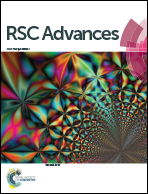High-energy proton irradiation damage on two-dimensional hexagonal boron nitride†
Abstract
The dielectric layer, which is an essential building block in electronic device circuitry, is subject to intrinsic or induced defects that limit its performance. Nano-layers of hexagonal boron nitride (h-BN) represent a promising dielectric layer in nano-electronics owing to its excellent electronic and thermal properties. In order to further analyze this technology, two-dimensional (2D) h-BN dielectric layers were exposed to high-energy proton irradiation at various proton energies and doses to intentionally introduce defective sites. A pristine h-BN capacitor showed typical degradation stages with a hard breakdown field of 10.3 MV cm−1, while h-BN capacitors irradiated at proton energies of 5 and 10 MeV at a dose of 1 × 1013 cm−2 showed lower hard breakdown fields of 1.6 and 8.3 MV cm−1, respectively. Higher leakage currents were observed under higher proton doses at 5 × 1013 cm−2, resulting in lower breakdown fields. The degradation stages of proton-irradiated h-BN are similar to those of defective silicon dioxide. The degradation of the h-BN dielectric after proton irradiation is attributed to Frenkel defects created by the high-energy protons, as indicated by the molecular dynamics simulation. Understanding the defect-induced degradation mechanism of h-BN nano-layers can improve their reliability, paving the way to the implementation of 2D h-BN in advanced micro- and nano-electronics.



 Please wait while we load your content...
Please wait while we load your content...